Farther eastward the ice-conditions are less favorable, and therefore few polar expeditions have directed their course through these regions. The original object of the Austro-Hungarian expedition under Weyprecht and Payer (1872–74) was to seek for the Northeast Passage; but at its first meeting with the ice it was set fast off the north point of Novaya Zemlya, drifted northward, and discovered Franz Josef Land, whence Payer endeavored to push forward to the north with sledges, reaching 82° 5′ north latitude on an island, which he named Crown-Prince Rudolf’s Land. To the north of this he thought he could see an extensive tract of land, lying in about 83° north latitude, which he called Petermann’s Land. Franz Josef Land was afterwards twice visited by the English traveller Leigh Smith in 1880 and 1881–82; and it is here that the English Jackson-Harmsworth expedition is at present established.
The plan of the Danish expedition under Hovgaard was to push forward to the North Pole from Cape Chelyuskin along the east coast of an extensive tract of land which Hovgaard thought must lie to the east of Franz Josef Land. He got set fast in the ice, however, in the Kara Sea, and remained the winter there, returning home the following year.
Only a few attempts have been made through Bering Strait. The first was Cook’s, in 1776; the last the Jeannette expedition (1879–81), under De Long, a lieutenant in the American navy. Scarcely anywhere have polar travellers been so hopelessly blocked by ice in comparatively low latitudes. The last-named expedition, however, had a most important bearing upon my own. As De Long himself says in a letter to James Gordon Bennett, who supplied the funds for the expedition, he was of opinion that there were three routes to choose from—Smith Sound, the east coast of Greenland, or Bering Strait; but he put most faith in the last, and this was ultimately selected. His main reason for this choice was his belief in a Japanese current running north through Bering Strait and onward along the east coast of Wrangel Land, which was believed to extend far to the north. It was urged that the warm water of this current would open a way along that coast, possibly up to the Pole. The experience of whalers showed that whenever their vessels were set fast in the ice here they drifted northwards; hence it was concluded that the current generally set in that direction. “This will help explorers,” says De Long, “to reach high latitudes, but at the same time will make it more difficult for them to come back.” The truth of these words he himself was to learn by bitter experience.
The Jeannette stuck fast in the ice on September 6th, 1879, in 71° 35′ north latitude and 175° 6′ east longitude, southeast of Wrangel Land—which, however, proved to be a small island—and drifted with the ice in a west-northwesterly direction for two years, when it foundered, June 12th, 1881, north of the New Siberian Islands, in 77° 15′ north latitude and 154° 59′ east longitude.
Everywhere, then, has the ice stopped the progress of mankind towards the north. In two cases only have ice-bound vessels drifted in a northerly direction—in the case of the Tegethoff and the Jeannette —while most of the others have been carried away from their goal by masses of ice drifting southward.
On reading the history of Arctic explorations, it early occurred to me that it would be very difficult to wrest the secrets from these unknown regions of ice by adopting the routes and the methods hitherto employed. But where did the proper route lie?
It was in the autumn of 1884 that I happened to see an article by Professor Mohn in the Norwegian Morgenblad , in which it was stated that sundry articles which must have come from the Jeannette had been found on the southwest coast of Greenland. He conjectured that they must have drifted on a floe right across the Polar Sea. It immediately occurred to me that here lay the route ready to hand. If a floe could drift right across the unknown region, that drift might also be enlisted in the service of exploration—and my plan was laid. Some years, however, elapsed before, in February, 1890, after my return from my Greenland expedition, I at last propounded the idea in an address before the Christiania Geographical Society. As this address plays an important part in the history of the expedition, I shall reproduce its principal features, as printed in the March number of Naturen , 1891.
After giving a brief sketch of the different polar expeditions of former years, I go on to say: “The results of these numerous attempts, as I have pointed out, seem somewhat discouraging. They appear to show plainly enough that it is impossible to sail to the Pole by any route whatever; for everywhere the ice has proved an impenetrable barrier, and has stayed the progress of invaders on the threshold of the unknown regions.
“To drag boats over the uneven drift-ice, which moreover is constantly moving under the influence of the current and wind, is an equally great difficulty. The ice lays such obstacles in the way that any one who has ever attempted to traverse it will not hesitate to declare it well-nigh impossible to advance in this manner with the equipment and provisions requisite for such an undertaking.”
Had we been able to advance over land, I said, that would have been the most certain route; in that case the Pole could have been reached “in one summer by Norwegian snow-shoe runners.” But there is every reason to doubt the existence of any such land. Greenland, I considered, did not extend farther than the most northerly known point of its west coast. “It is not probable that Franz Josef Land reaches to the Pole; from all we can learn it forms a group of islands separated from each other by deep sounds, and it appears improbable that any large continuous track of land is to be found there.
“Some people are perhaps of opinion that one ought to defer the examination of regions like those around the Pole, beset, as they are, with so many difficulties, till new means of transport have been discovered. I have heard it intimated that one fine day we shall be able to reach the Pole by a balloon, and that it is only waste of time to seek to get there before that day comes. It need scarcely be shown that this line of reasoning is untenable. Even if one could really suppose that in the near or distant future this frequently mooted idea of travelling to the Pole in an air-ship would be realized, such an expedition, however interesting it might be in certain respects, would be far from yielding the scientific results of expeditions carried out in the manner here indicated. Scientific results of importance in all branches of research can be attained only by persistent observations during a lengthened sojourn in these regions, while those of a balloon expedition cannot but be of a transitory nature.
“We must, then, endeavor to ascertain if there are not other routes—and I believe there are. I believe that if we pay attention to the actually existent forces of nature, and seek to work with and not against them, we shall thus find the safest and easiest method of reaching the Pole. It is useless, as previous expeditions have done, to work against the current; we should see if there is not a current we can work with . The Jeannette expedition is the only one, in my opinion, that started on the right track, though it may have been unwittingly and unwillingly.
“The Jeannette drifted for two years in the ice, from Wrangel Land to the New Siberian Islands. Three years after she foundered to the north of these islands there was found frozen into the drift-ice, in the neighborhood of Julianehaab, on the southwest coast of Greenland, a number of articles which appeared, from sundry indubitable marks, to proceed from the sunken vessel. These articles were first discovered by the Eskimo, and were afterwards collected by Mr. Lytzen, Colonial Manager at Julianehaab, who has given a list of them in the Danish Geographical Journal for 1885. Among them the following may especially be mentioned:
Читать дальше












